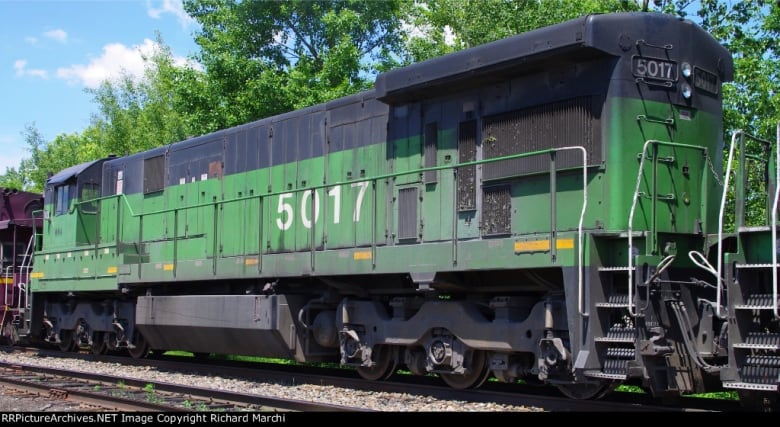Lead locomotive not up to 'basic standard' to prevent runaway train, Lac-Mégantic trial hears
Retrofitted locomotive 5017 was wired in such a way that engine’s automatic brakes didn’t kick in
The railway accident expert who investigated the deadly 2013 derailment of a 74-car fuel train in Lac-Mégantic said Monday had another locomotive been at the head of the convoy, air brakes would automatically have been applied to the whole train after the extinguishing of an engine fire an hour before the tragedy.
Stephen Callaghan, an expert witness hired by the provincial police after the disaster, told a Sherbrooke court the notorious lead locomotive, number 5017, had been retrofitted, and its wiring differed from most other locomotives in the industry.
Three former Montreal, Maine and Atlantic (MMA) employees — locomotive engineer Thomas Harding, 56, operations manager Jean Demaître, 53, and rail traffic controller Richard Labrie, 59 — are on trial for criminal negligence causing 47 deaths.
Request to switch locomotive refused
Earlier in the trial, Superior Court Justice Gaétan Dumas and jurors heard that François Daigle, the engineer who drove locomotive 5017 the day before Harding's ill-fated last trip, had noticed mechanical problems with the engine.
Daigle testified he had asked his supervisor, Jean Demaître, to switch it for another locomotive — a request Demaître had refused.
The court also heard that firefighters had shut off all of the breakers on lead locomotive 5017 when a fire broke out in its smokestack shortly after it had been left idling on the tracks in Nantes, Que., 12 kilometres from downtown Lac-Mégantic about an hour before the derailment.
Penalty brake never kicked in
The court heard trains have a backup defence mechanism called a penalty brake, in which all air brakes are automatically applied to the whole train.
One of Harding's lawyers, Charles Shearson, asked Callaghan about how locomotive 5017 differed from the others in the convoy when it came to how the penalty brake kicked in.
"You said on this locomotive, when the breakers were put off, this did not trigger a penalty brake application?" asked Shearson.
"That is correct," answered Callaghan.

"Normally, not with this locomotive but with other locomotives, when the breakers are shut off, would a penalty brake application be expected?" continued Shearson.
"We tested all five locomotives configured as a lead locomotive. Four of the five functioned in the manner you described. When you drop the breakers, you get a penalty application," answered Callaghan. "[Locomotive] 5017 does not."
"So if you have one of the others in the lead, and a few minutes later we stop the breaker, it would create a default penalty?" asked Shearson.
"Yes, because at that point, you would have enough pressure for your brake system to function properly," Callaghan said.
Callaghan went on to explain that an examination of the wiring diagrams for each locomotive revealed that locomotive 5017 was retrofitted and wired in such a way that the penalty brake application did not come on when the breakers had been shut off.
"What is the standard?" asked Justice Dumas.
"The basic standard is that without electricity, they activate," said Callaghan.
"Like the four others?" questioned Dumas.
"Like the four other locomotives."
Sub-par maintenance of air brakes on runaway train
Earlier in his testimony, Callaghan told the court the locomotives which were part of the runaway convoy had numerous defects, which he'd observed during his inspection.
Thomas Walsh, another of Harding's lawyers, referred to a report Callaghan had prepared in conclusion to his investigation.
"You conclude the mechanical condition of the locomotives demonstrates a clear lack of disciplinary maintenance of mechanical, electrical and air brake system of locomotives despite regulatory requirements, and lack of inspection and maintenance accelerated the loss of air in the brake system and the runaway train?" asked Walsh.
"That is correct," said Callaghan. "The air brake portion of locomotive maintenance didn't respect regulations."
"Four of the five locomotives did not comply."
1-person crews again called into question
Monday was Callaghan's fifth day and final day in the witness box.
Last Thursday, he testified on the extensive discussions with Transport Canada that came before permission was granted to his former employer, the Quebec North Shore and Labrador (QNSL) railway, to run one-person crew operations.
He told the court 69 conditions had to be filled before one-man crews were given the green light. He said QNSL was the only railway in Canada to operate with a locomotive engineer working alone for "a long time."
Under cross-examination by Walsh, Callaghan told the court that Transport Canada eventually modified the rules governing one-person crews, and by the time MMA implemented the practice, "no direct authorization was given by Transport Canada and, given the structure of the rules, none was required."
Earlier in the trial, the court heard the only requirement for MMA to begin using single-person crews was to install a mirror on the driver's side of the locomotive.
- Few safety precautions for MMA's 1-person crews, Lac-Mégantic trial hears
- Trial synopsis: A train's faulty engine, safety standards ignored and other revelations
The trial continues Tuesday.
Corrections
- A previous version of this story reported the three defendants are charged with 47 counts each of criminal negligence causing death — one count for each person who died in the Lac-Mégantic rail disaster. In fact, prior to the trial, the Crown simplified the charge to a single count each of criminal negligence causing 47 deaths. The change has no bearing on the criteria used by the jury to render its verdict or on the possible sentence.Jan 15, 2018 7:02 PM ET